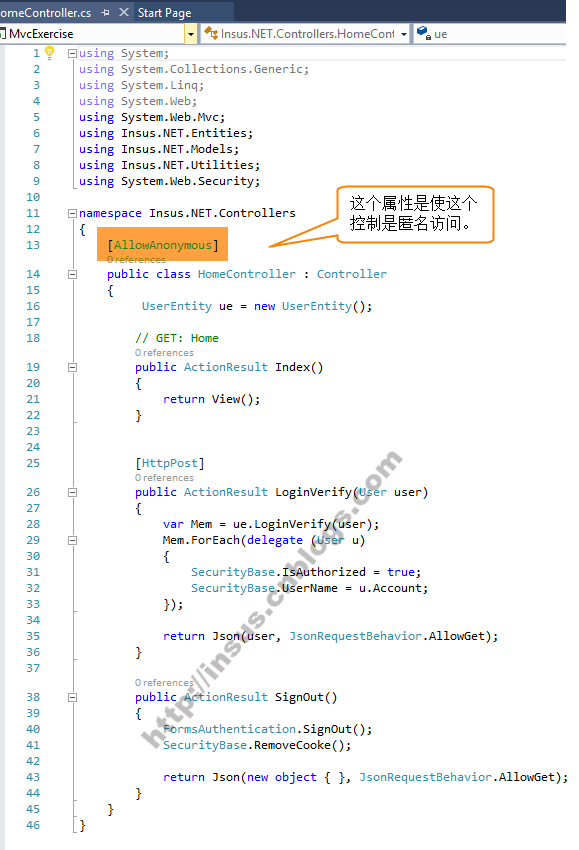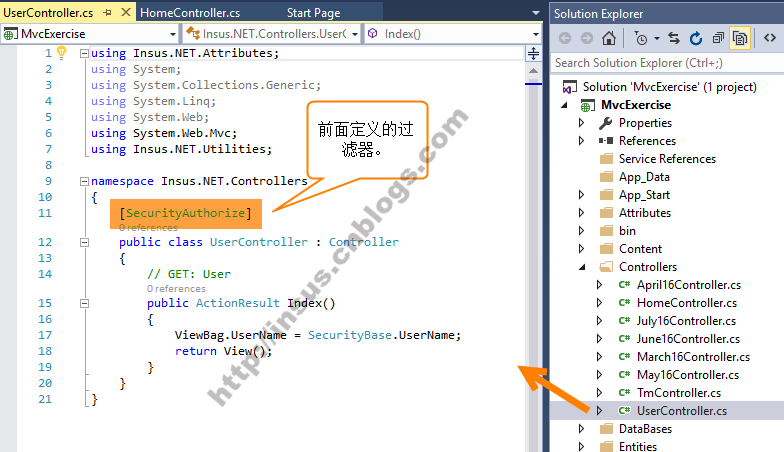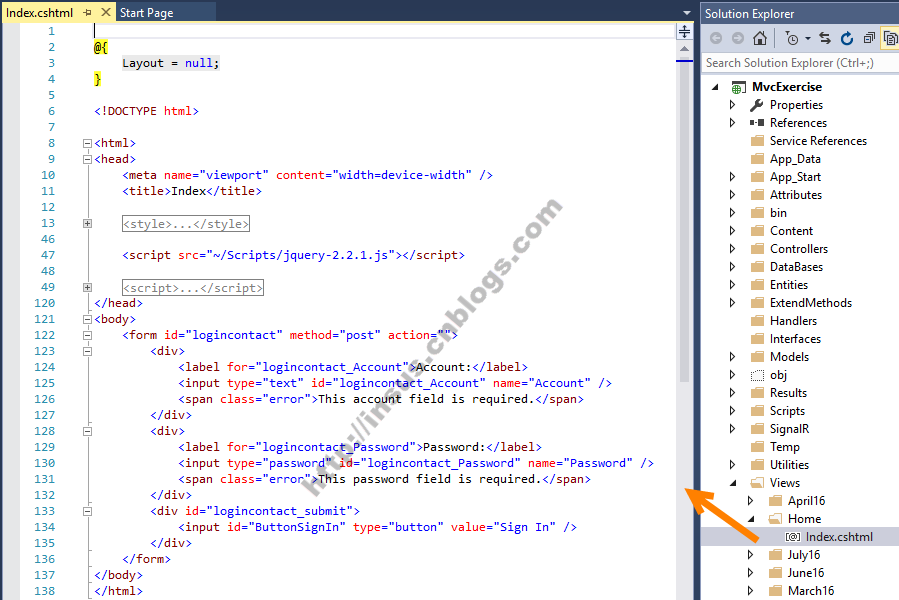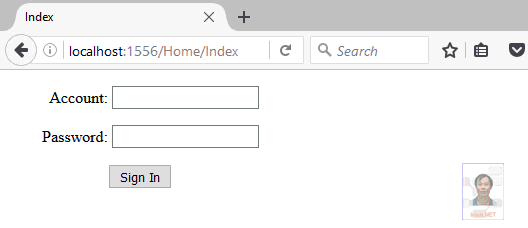前几天Insus.NET有在数据库实现过对某一字段进行加密码与解密《使用EncryptByPassPhrase和DecryptByPassPhrase对MS SQLServer某一字段时行加密和解密》http://www.cnblogs.com/insus/p/5983645.html
那今次Insus.NET在ASP.NET MVC实现自定义验证Authorize Attribute。
实现之前,Insus.NET对usp_Users_VeryLoginVerify修改一下,改为更好理解与使用:

SET ANSI_NULLS ON GO SET QUOTED_IDENTIFIER ON GO ALTER PROCEDURE [dbo].[usp_Users_VeryLoginVerify] ( @U_nbr NVARCHAR(20), @pwd NVARCHAR(100) ) AS BEGIN DECLARE @errmsg NVARCHAR(50) = N'用户名或密码错误。' IF NOT EXISTS(SELECT TOP 1 1 FROM [dbo].[Users] WHERE [U_nbr] = @U_nbr) BEGIN RAISERROR(@errmsg,16,1) RETURN END SELECT [U_nbr] AS [Account] FROM [dbo].[Users] WHERE [U_nbr] = @U_nbr AND CONVERT(NVARCHAR(100),DECRYPTBYPASSPHRASE('insus#sec!%y',[Pwd])) = @pwd IF @@ROWCOUNT <= 0 BEGIN RAISERROR(@errmsg,16,1) RETURN END END
OK,上面是数据库方面。
接下你需要在ASP.NET MVC写程序:
使用Cookie来存储登录以及验证信息,写一个Cookie类别:

using System; using System.Collections.Generic; using System.Linq; using System.Web; namespace Insus.NET.Utilities { public abstract class CookieBase { private static HttpResponse Response { get { return HttpContext.Current.Response; } } private static HttpRequest Request { get { return HttpContext.Current.Request; } } public static HttpCookie Cookie { get { return Request.Cookies["CookieBase"] as HttpCookie; } set { if (Request.Cookies["CookieBase"] != null) { Request.Cookies.Remove("CookieBase"); } Response.Cookies.Add(value); } } public static HttpCookie NewCookie { get { return new HttpCookie("CookieBase"); } } public static void RemoveCookie() { if (Cookie == null) Response.Cookies.Remove("CookieBase"); else Response.Cookies["CookieBase"].Expires = DateTime.Now.AddDays(-1); } } }
其实上面这个CookeBase.cs是一个能存储多对象的集合类。在真正的程序中,你想存储什么信息,可以写一个如下面的类来操作:

using System; using System.Collections.Generic; using System.Linq; using System.Text; using System.Threading.Tasks; using System.Web; namespace Insus.NET.Utilities { public class SecurityBase { public static bool IsAuthorized { get { return CookieBase.Cookie == null ? false : bool.Parse(CookieBase.Cookie.Values["IsAuthorized"]); } set { HttpCookie httpCookie = CookieBase.Cookie == null ? CookieBase.NewCookie : CookieBase.Cookie; httpCookie.Values["IsAuthorized"] = value.ToString(); CookieBase.Cookie = httpCookie; } } public static string UserName { get { return CookieBase.Cookie == null ? string.Empty : CookieBase.Cookie.Values["UserName"]; } set { HttpCookie httpCookie = CookieBase.Cookie == null ? CookieBase.NewCookie : CookieBase.Cookie; httpCookie.Values["UserName"] = value; CookieBase.Cookie = httpCookie; } } public static void RemoveCooke() { CookieBase.RemoveCookie(); } } }

using System; using System.Collections.Generic; using System.Linq; using System.Text; using System.Threading.Tasks; using System.Web; using System.Web.Mvc; using Insus.NET.Utilities; using System.Web.Routing; namespace Insus.NET.Attributes { public class SecurityAuthorizeAttribute : AuthorizeAttribute { protected override bool AuthorizeCore(HttpContextBase httpContext) { return SecurityBase.IsAuthorized; } public override void OnAuthorization(AuthorizationContext filterContext) { string controllerName = filterContext.ActionDescriptor.ControllerDescriptor.ControllerName; string actionName = filterContext.ActionDescriptor.ActionName; base.OnAuthorization(filterContext); } protected override void HandleUnauthorizedRequest(AuthorizationContext filterContext) { var routeValue = new RouteValueDictionary { { "Controller", "Home"}, { "Action", "Index"} }; filterContext.Result = new RedirectToRouteResult(routeValue); } } }
这个过滤器SecurityAuthorizeAttribute.cs,稍后我们会在控制器中应用到它。
接下你需要写控制器了,不,我们似乎少写了一些物件,如model和Entity:
Models写好,还差一个Entity,这个实体是与数据连接的物件:
在ASP.NET MVC中,实现登录验证的演示,最少需要两个控制器,一个是给匿名用户访问的,它包含普通的页面和一些基本的操作。另一个控制器是经过验证通过之后才能访问的页面。

@{ Layout = null; } <!DOCTYPE html> <html> <head> <meta name="viewport" content="width=device-width" /> <title>Index</title> <style type="text/css"> #logincontact label { display: inline-block; width: 100px; text-align: right; } #logincontact_submit { padding-left: 100px; } #logincontact div { margin-top: 1em; } .error { display: none; margin-left: 10px; } .error_show { color: red; margin-left: 10px; } input.invalid { border: 2px solid red; } input.valid { border: 2px solid green; } </style> <script src="~/Scripts/jquery-2.2.1.js"></script> <script type="text/javascript"> ////<![CDATA[ $(document).ready(function () { $('#logincontact_Account').on('input', function () { var input = $(this); var is_Account = input.val(); if (is_Account) { input.removeClass("invalid").addClass("valid"); } else { input.removeClass("valid").addClass("invalid"); } }); $('#logincontact_Password').on('input', function () { var input = $(this); var is_Password = input.val(); if (is_Password) { input.removeClass("invalid").addClass("valid"); } else { input.removeClass("valid").addClass("invalid"); } }); $('#ButtonSignIn').click(function (event) { var form_data = $("#logincontact").serializeArray(); var error_free = true; for (var input in form_data) { var element = $("#logincontact_" + form_data[input]['name']); var valid = element.hasClass("valid"); var error_element = $("span", element.parent()); if (!valid) { error_element.removeClass("error").addClass("error_show"); error_free = false; } else { error_element.removeClass("error_show").addClass("error"); } } if (!error_free) { event.preventDefault(); } else { var obj = {}; obj.Account = $('#logincontact_Account').val(), obj.Password = $('#logincontact_Password').val() $.ajax({ type: 'POST', url: '/Home/LoginVerify', dataType: 'json', data: JSON.stringify(obj), contentType: 'application/json; charset=utf-8', success: function (data, textStatus) { alert("登录成功。"); window.location.href = "/User/Index"; }, error: function (XMLHttpRequest, textStatus, errorThrown) { alert(errorThrown); }, }); } }); }); //]]> </script> </head> <body> <form id="logincontact" method="post" action=""> <div> <label for="logincontact_Account">Account:</label> <input type="text" id="logincontact_Account" name="Account" /> <span class="error">This account field is required.</span> </div> <div> <label for="logincontact_Password">Password:</label> <input type="password" id="logincontact_Password" name="Password" /> <span class="error">This password field is required.</span> </div> <div id="logincontact_submit"> <input id="ButtonSignIn" type="button" value="Sign In" /> </div> </form> </body> </html>

@{ Layout = null; } <!DOCTYPE html> <html> <head> <meta name="viewport" content="width=device-width" /> <title>Index</title> <script src="~/Scripts/jquery-2.2.1.js"></script> <script type="text/javascript"> ////<![CDATA[ $(document).ready(function () { $('#ButtonSignOut').click(function (event) { $.ajax({ type: 'POST', url: '/Home/SignOut', contentType: 'application/json; charset=utf-8', success: function (data, textStatus) { alert("已经安全退出网站。"); window.location.href = "/Home/Index"; }, error: function (XMLHttpRequest, textStatus, errorThrown) { alert(errorThrown); }, }); }); }); //]]> </script> </head> <body> <div> Hi @ViewBag.UserName <br /> <input id="ButtonSignOut" type="button" value="Sign Out" /> </div> </body> </html>





